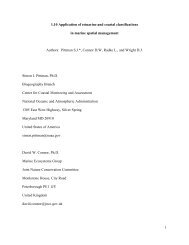Seamounts, Ridges, and Reef Habitats of American Samoa
Seamounts, Ridges, and Reef Habitats of American Samoa
Seamounts, Ridges, and Reef Habitats of American Samoa
- No tags were found...
You also want an ePaper? Increase the reach of your titles
YUMPU automatically turns print PDFs into web optimized ePapers that Google loves.
<strong>Seamounts</strong>, <strong>Ridges</strong>, <strong>and</strong> <strong>Reef</strong> <strong>Habitats</strong> <strong>of</strong> <strong>American</strong> <strong>Samoa</strong> 795f0015Figure 58.2 Geomorphic interpretation <strong>of</strong> major volcanic features <strong>of</strong> the isl<strong>and</strong>s <strong>of</strong> <strong>American</strong><strong>Samoa</strong> <strong>and</strong> the broader ESVP, based on the multibeam bathymetry <strong>of</strong> Figure 58.1. Major riftzones are shown in black, subaerial <strong>and</strong> submarine eruptive centers in red, volcanic plateaus instipple, outlines <strong>of</strong> the most prominent large seamounts in dashed circles, <strong>and</strong> small seamountsin small open circles. Cross-hatching indicates no multibeam bathymetry coverage. Largedashed line shows the northeasterly volcanic rift trend <strong>of</strong> Tutuila, which differs markedly fromthe southeasterly trends <strong>of</strong> the two major seamount chains directly to the east (shorter dashedlines). (For interpretation <strong>of</strong> the references to color in this figure legend, the reader is referredto the web version <strong>of</strong> this book.)p0075p0080direction. Tutuila may in fact be an extension <strong>of</strong> the North Fiji Fracture Zone far tothe east, which also trends 70° [31].The morphology <strong>of</strong> Tutuila exhibits several highly incised secondary rift zonesradiating away from the primary trend (Figure 58.3). Protruding slightly from thesouthwestern corner <strong>of</strong> the isl<strong>and</strong> is a rift oriented 20°. Reinstating the primaryen echelon trend, a massive rift protrudes at 110° <strong>and</strong> connects to 2% Bank (akaTulaga). A third rifting system extends from the northeastern corner <strong>of</strong> the isl<strong>and</strong> ina 30° trend. The linear nature <strong>of</strong> these features implies structural guidance <strong>of</strong> volcanismby fault or fracture zone. The isl<strong>and</strong> flanks are in a stage <strong>of</strong> advanced erosion,exhibiting numerous slope failures <strong>and</strong> incised rifts (Figure 58.3). Sparse populations<strong>of</strong> small seamounts occupy the western flank, as well as the northern <strong>and</strong> southernflanks, which are in line with the primary rift <strong>of</strong> South Bank.South Bank: South Bank (aka Papatua Guyot) is the largest isolated edifice in theESVP. Though it has not been radiometrically dated, it is probably at least as old asTutuila, based on its location in the ESVP. The summit <strong>of</strong> South Bank sits very near
















